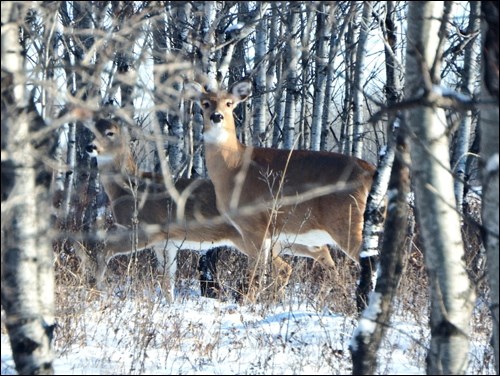Today’s column offers examples of wildlife that may be hunted in Saskatchewan without a licence.
Wildlife as defined under The Wildlife Act, 1998 means a vertebrate animal of any species, excluding fish, that is wild by nature in Saskatchewan and any exotic wildlife found in Saskatchewan.
The Saskatchewan Wildlife Regulations, 1981, establish which species of wildlife may be taken without a licence. Wildlife such as rabbits, shrews, rats, skunks and raccoons are examples of mammals that can be hunted without a licence. House sparrows, crows, magpies, common pigeons and certain blackbirds are some of the birds that can be hunted without a licence.
Furbearing animals are protected under The Wildlife Regulations, 1981. These animals can only be harvested by a licensed trapper or a First Nations person exercising Treaty rights. However, there are exceptions in certain areas of the province. Coyotes may be taken without a licence in the ¬È∂π¥´√ΩAVern Fur Conservation Area (SFCA) by Saskatchewan residents only. Beaver may also be taken without a fur licence in rural municipalities that have passed a bylaw allowing beavers to be hunted and have filed a copy of the bylaw with the ministry.
Wild boars may be hunted by Saskatchewan residents without a licence. A person hunting coyotes or wild boar may not accompany, hunt with, aid or assist a person hunting big game. Non-residents, and Canadian residents are not allowed to hunt coyotes or wild boar in the province.
Regardless of what you are hunting, please remember to respect private land. Until the new trespassing legislation comes into effect, hunters are encouraged to ask permission to hunt on unposted land and must have permission to hunt on posted land.
Other species of wildlife that some may consider a nuisance are fully protected, such as porcupine, fox, muskrat, merlin and kestrel. Protected wildlife may not be hunted unless authorized under a licence or permit. However, for the purpose of protecting property, including livestock, the owner or occupant of any land may kill any raven, rattlesnake, carnivore, beaver or muskrat without a licence. Swift fox or black-footed ferret may not be killed, but any beaver house or dam on that land may be destroyed and immediately reported to a conservation officer.
Even though we are in the fall, people still come across antler sheds from deer, elk and moose. Most of this activity occurs in April after antlers have dropped and they are easy to find in the melting snow, but sheds are also found at this time of year when people are pushing bush..
Remember, if you find a set of antlers attached to a skull, it is not a shed. You know you have a shed when there is a rounded stub below the burr on the antler. These sheds can be possessed and sold without a permit.
Here are some recent questions that have come up:
Q: I have a cabin at a lake and own extensive farm land nearby. If I was marketing my cabin as a rental to hunters from Canada and the United States with the inclusion of access to my farmland to hunt, would I be breaking any laws?
Great question. If you are solely renting out your house or cabin with no other hunting services or equipment provided, then it is legal. However, it is illegal to charge for access to land for hunting.
The Outfitter and Guide Regulations, 2004 define an outfitter as a person who, for or in expectation of any fee, financial gain or reward, provides or organizes the following services for clients in connection with angling or hunting:
the services of a guide;
(ii) equipment and accommodation;
(iii) any combination of the services mentioned in subclauses (i) and (ii).
Q: If I am shooting migratory birds, can they be shot at on the ground, on the water or do they have to be shot while in flight?
It is not illegal to shoot migratory birds on the ground or on the water. However, waterfowl are most often taken in flight. It is important to make sure that the bird is within range. Good hunters know their shooting capabilities and the capabilities of their firearms and do not shoot at waterfowl beyond a reasonable range (30 metres).
A person who kills or injures any game shall make every reasonable effort to retrieve the game and include it in his or her lawful limit.
That should do it for another week… until next time make sure your gun is sighted in.
Ministry of Environment conservation officer Lindsey Leko has spent more than 26 years as a conservation officer in Saskatchewan. For many years, Officer Leko contributed a column to local papers on a variety of issues related to hunting, fishing, and other resource-related issues. If you have questions, please contact




